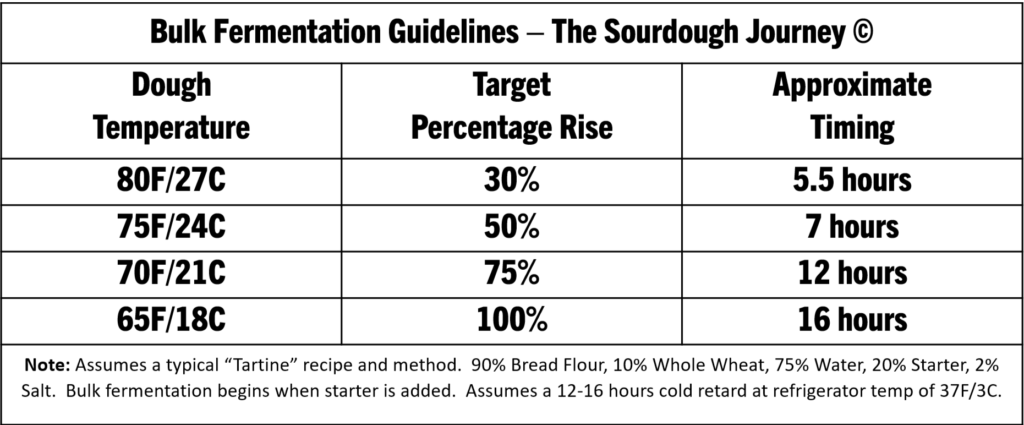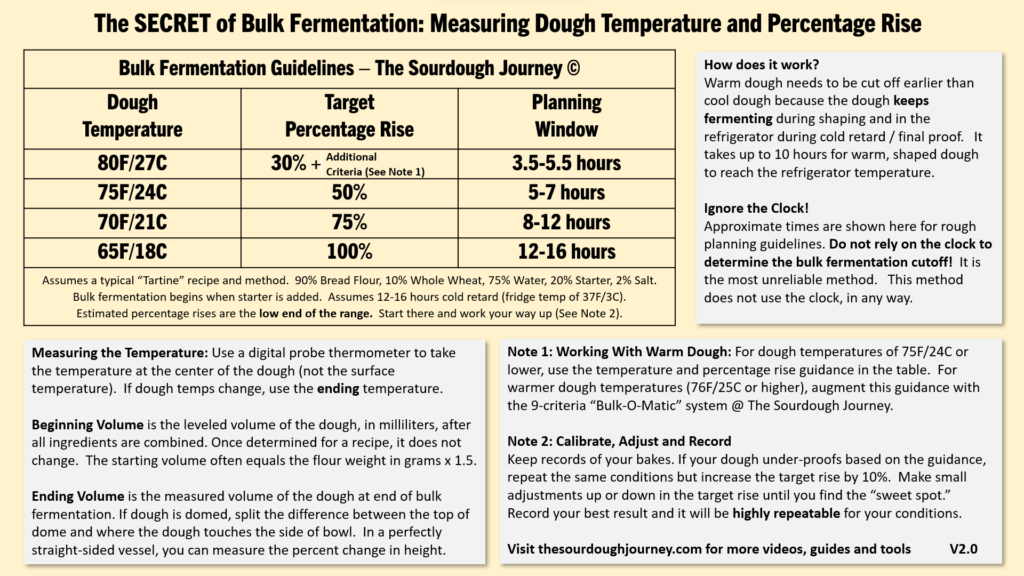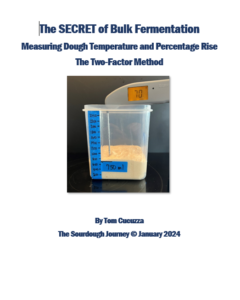What is sourdough "dough temping" and how does it work?
Dough Temping for PERFECT Sourdough Fermentation
By Tom Cucuzza, The Sourdough Journey © May 2024
What is “Dough Temping?”
“Dough Temping” simply means taking the temperature of your dough during bulk fermentation.
Why is it important?
Bulk fermentation is one of the most challening aspects of sourdough baking. Perfectly fermented dough is the key to a tall, open, airy crumb. Bulk fermentation is the most important step in sourdough baking and it produces 80%, or more, of what you see in the final outcome of the loaf.
However, bulk fermentation is incredibly challenging because the fermentation process is temperature dependent. Warm dough ferments much faster than cool dough, so sourdough bakers need to be aware of their dough temperature at all times.
Perfecting Bulk Fermentation
Sourdough baking is challenging for beginners because it requires experience to learn when the dough is fully fermented. Most popular recipes and guides don’t offer much help in learning this skill. The most common guidance is:
- “Let your dough double in size at room temperature,” or
- “Learn to read the dough.”
This is some of the worst guidance in the history of baking instruction.
The Two-Factor Method – Measuring Temperature and Percentage Rise
After years of research and hundreds of experiments, I’ve developed a new method for beginners (and experiened bakers) to easily determine when bulk fermentation is finished — by measuring the dough temperature and the percentage rise in the dough.
I first described this method in the article, “The Mystery of Percentage Rise in Bulk Fermentation,” when I published this popular chart:

How does it work?
The method is quite simple. You should measure the percentage rise in your dough during bulk fermentation, and your dough temperature. Warm fermenting dough needs to be cut off earlier than cool fermenting dough.
The method allows you to ignore the clock and simply measure the temperature and percentage rise.
For example, dough fermenting at 80F/27C should be cut off at about a 30% rise, and dough fermenting at 70F/21C should be cut off at a 75% rise. These cutoffs assume a cold retard / final proof in the refrigerator.
The reason you need to cut off the rise of warm dough earlier than cool dough is because warm dough keep fermenting in the refrigerator. When fermenting warm dough, you need to hit the brakes earlier than with cooler dough.
You will find a one-page chart, video link and detailed guide below. I encourage you to review all three to fully understand how the method works.
The Method
The method can be summarized as:
1) Follow the guidance for your initial bake. Based on your dough temperature, monitor the dough rise during bulk fermentation and cut off the rise at the prescribed guidance. The guidance provided, is generally the low end of the range. You will rarely overproof at the target guidance, but may underproof.
2) After baking your loaf, assess the crumb based on the guidance provided here How to Read a Sourdough Crumb Guide.
3) If your loaf is underproofed, increase the target percentage rise by 10% and repeat the same process. Continue these steps until your loaf is perfectly proofed (usually right on the edge of overproofing). You can usually find the perfect percentage rise in a few bakes.
4) Document your target percentage rise for that recipe and temperature. The results should then be highly repeatable every time you follow the same recipe at that temperature. Over time, if you keep good notes, you can take all of the guesswork out of bulk fermentation.
Consult the document below for more details and FAQs.
Tools, Guides and Videos
Over the past few years, I have developed a complete suite of tools to master the two-factor method — measuring dough temperature and percentage rise — for perfect sourdough fermentation.
The Chart
This chart summarizes the method in a one-page quick reference guide. I also recommend watching the video and reviewing the detailed guide below.

The Video
This detailed video explains the science and practice behind the method.
If you find these tools and guides to be helpful, please make a donation to The Sourdough Journey at https://thesourdoughjourney.com/donate/
Copyright 2024 (c) The Sourdough Journey

